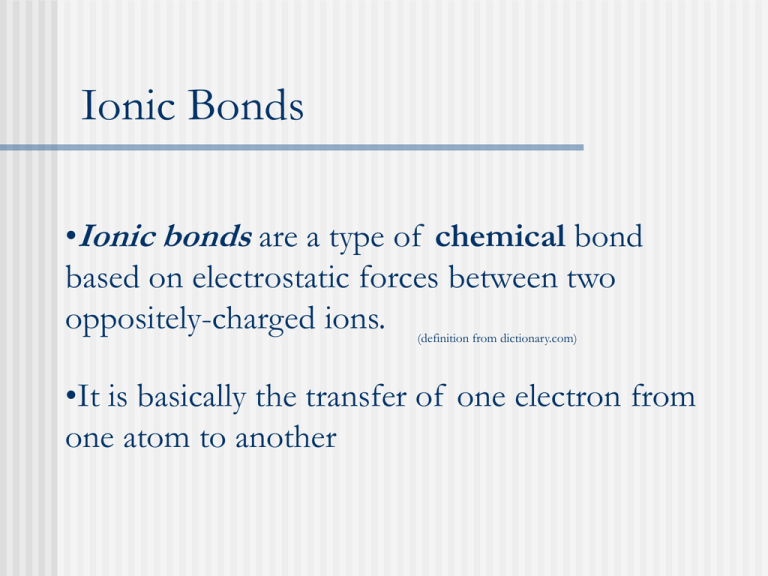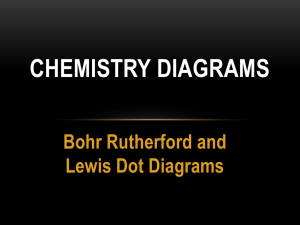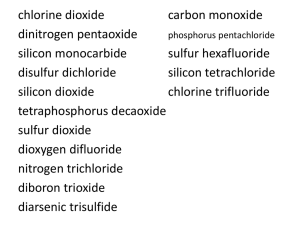ionic bonds
advertisement

Ionic Bonds •Ionic bonds are a type of chemical bond based on electrostatic forces between two oppositely-charged ions. (definition from dictionary.com) •It is basically the transfer of one electron from one atom to another Ionic Bonds •To understand ionic bonding, you should first have a solid understanding of ions. •An ion is an atom or group of atoms that have a charge. Atoms normally have a neutral charge because most often they have the same number of electrons and protons. They become ions by the loss or addition of one or more electrons. This process is called ionization. •An ion that has more electrons than protons is called an anion, and an ion that has fewer electrons than protons is called a cation. Ionic Bonds •The name ion was given by a man named Michael Faraday, which comes from a Greek word meaning “to go” or “a goer”. •The word anion comes from the Greek word meaning (a thing) “going up” and cation means (a thing) “going down”. Ionic Bonds •Now that you have a good understanding of ions, we can learn about ionic bonding. •The interaction of ionic bonds is when atoms gain or lose electrons until the outer shell of electrons is full and stable with 8 electrons. This is part of the octet rule. •The octet rule is very useful but you should also know that there are many bonding situations where it does not apply. This means that it is a helpful tool but you can not always depend on it. Ionic Bonds •The number of electrons the atom gains, loses, or shares is called its Valence. •Ionic boding most often occurs between a metal and a nonmetal. •If think about it, nonmetals usually have four or more electrons in their outer shell. To make their outer shell full, it’s easier, meaning it takes less ionization energy, for them to gain three or four electrons than to lose four or five electrons. •On the other hand, if you look at the metals, they usually have three or less electrons in their outer shell. Opposite from nonmetals, it is easier for metals to lose three or less electrons than to gain four or more. •This is why it makes sense that metals and nonmetals bond easily. Lewis Dot Structure •In 1902, Gilbert Newton Lewis, born October 23, 1875, invented the valance bond theory. Lewis was a famous American physical chemist and he developed his theory in coordination with Irving Langmuir. •Lewis came up with an easy way to represent electrons in the outer shells of ions. His invention is called “Lewis Dot Symbols”. Gilbert Newton Lewis Lewis Dot Structures Lewis Dot Structure •Lewis structures are an way to better visualize the valence electrons of elements. In the Lewis model, an element symbol is inside the valence electrons of the s and p subshells of the outer ring. •You may notice that the transition elements were not shown on the chart, as well as the lanthanides and actinides. The Lewis Dot structure doesn’t work with these elements. They do not follow with the octet rule because the first shell has a capacity for 2 valence electrons. Without these elements in the chart, every electron shell beyond the first has a total capacity for 8 outer shell electrons, complimenting the octet rule. Sodium, Na, needs to lose one electron to become stable. Chlorine, Cl, needs to gain one to become stable. Together they make an ionic bond. NaCl, or salt. Na +1 Cl 1- Lewis Dot Structure Lewis Dot Structure •Another example: Sulfur has 16 electrons. You can show this by using the method we learned earlier in the year [Ne]3s23p4. You can see from using this method that there are 6 electrons in the outer shell of sulfur. Sulfur can be represented in Lewis dots when you follow these rules: 1. The element symbol is placed in the center. 2. Dots, representing electrons, are placed on all four sides of the element. 3. Each side can hold 2 electrons. 4. You must put an electron on each side (if possible) before filling up a side. Lewis Dot Structure … So this is what sulfur looks like according to the Lewis Dot Chart: S Lewis Dot Structure •Now it’s your turn to try and draw some elements using the Lewis Dot Structure. 1. Potassium 2. Germanium 3. Phosphorus 4. Neon 5. Aluminum * Lewis Dot Structure Lewis Dot Structure • Using what you know already, we can predict what carbon dioxide, CO , will look like using Lewis Dots. 2 C O O It works! Lewis Dot Structure •This is the result of CO2 C +4 O O •You can see that the Oxygens have 8 electrons in their outer shells, but how many electrons are in Carbon’s outer shell? 6 Quiz! 1. The negative ion F- has the same electronic configuration as the positive ion -----. Ca2+ Li+ Mg2+ K+ Sc3+ Quiz! 2. Lithium and chloride react to form LiCl, an ionic compound. The chloride ion has ----- electrons in its outermost occupied shell. 6 2 8 18 7 Quiz! 3. Mg and N react to form Mg3N2, an ionic compound. Mg2+ has ----- electrons on its highest occupied energy level. 8 2 10 4 5 Quiz! 4. What is the charge on a simple (single atom) ion that sulfur forms? 1+ 2+ 3+ 12- Quiz! 5. Consider the formation of one formula unit of Li3N from neutral atoms. In the process each Li atom ----- electron(s) and each N atom ----- electron(s). gains 3, loses 1 loses 3, gains 1 loses 3, gains 3 loses 1, gains 3 gains 1, loses 3 Quiz! 6. In the Lewis dot structure of CO2, the number of unshared pairs of electrons in the outer shell of the central atom is -- one two three four zero Quiz questions taken from: http://gemini.tntech.edu/~snorthrup/chem111/tutorials/chap7/prob1q.html







